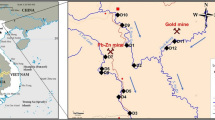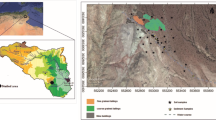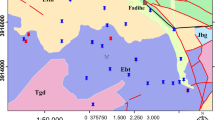Abstract
Five mine water samples, 23 topsoil samples, and four mine waste (tailings) samples were collected to assess the effects of a closed Moroccan Mn mine. Based on the pH, electrical conductivity, and concentrations of sulphate, Cu, Zn, As, Cd, Pb, and Mn, mining has not adversely influenced mine water quality. Soil samples were analyzed for 23 chemical elements and the results were interpreted by univariate and multivariate statistical techniques. Based on an enrichment factor (EF) calculation, only Cd, As, V, and Mn were selected for further study. Geochemical background (GB) and geoaccumulation index (Igeo) were determined for these elements to differentiate between geogenic and anthropogenic enrichment. The GB values showed that the Tiwiyyine soils contained a high geogenic content of Cd, As, V, and Mn that reflected the geochemistry of the parental rocks in this mineralized region. The Igeo calculation revealed that these soils were moderately influenced by anthropogenic activity, which had increased the concentrations of those elements. Finally, geochemical maps revealed that mining was likely responsible for the anthropogenic soil pollution.
Zusammenfassung
5 Grubenwasserproben, 23 Proben des Oberbodens und 4 Tailingsproben wurden genommen, um die Auswirkungen eines marokkanischen Manganbergwerks zu bewerten. Ausgehend von pH-Wert, elektrischer Leitfähigkeit und den Konzentrationen von Sulfat, Cu, Zn, As, Cd, Pb und Mn hat der Bergbau die Wasserqualität nicht negativ beeinflusst. Die Bodenproben wurden auf 23 chemische Elemente untersucht. Die Ergebnisse wurden mittels uni- und multivariater statistischer Methoden bewertet. Basierend auf der Berechnung eines Anreicherungsfaktors (EF) wurden nur Cd, As, V und Mn in die weiteren Betrachtungen einbezogen. Um zwischen geogener und anthropogener Anreicherung zu unterscheiden, wurden der geologische Hintergrund (GB) und der Geoakkumulalationsindex (Igeo) für diese Elemente bestimmt. Die geogenen Hintergrundwerte zeigten, dass die Böden von Tiwiyyine hohe geogene Gehalte an Cd, As, V und Mn haben, die die Geochemie des Muttergesteins in dieser erzreichen Gegend widerspiegeln. Die Berechnung des Igeo erbrachte, dass menschliche Aktivität diese Böden mäßig beeinflusst und die Konzentrationen der genannten Elemente erhöht haben. Geochemische Karten zeigten, dass diese anthropogene Bodenkontamination wahrscheinlich durch den Bergbau verursacht wurde.
Resumen
Se colectaron 5 muestras de agua de mina, 23 muestras de suelo superficial y 4 muestras de colas para analizar los efectos de una mina de manganeso actualmente cerrada. En base a las medidas de pH, de conductividad eléctrica y de las concentraciones de sulfato, Cu, Zn, As, Cd, Pb y Mn, se puede concluir que la minería no ha afectado la calidad del agua de mina. Se analizaron 23 elementos quimicos en las muestras de suelos y los resultados fueron interpretados por técnicas estadísticas univariantes y multivariantes. Basados en los cálculos del factor de enriquecimiento (EF), sólo Cd, As, V y Mn fueron seleccionados para estudios posteriores. El fondo geoquímico (GB) y el índice de geoacumulación (Igeo) fueron determinados para estos elementos para diferenciar entre enriquecimiento geogénico y antropogénico. Los valores GB mostraron que los suelos Tiwiyyine contenían un alto contenido geogénico de Cd, As, V y Mn que reflejaban la geoquímica de las rocas en esta región mineralizada. El cálculo Igeo reveló que los suelos estaban moderadamente influenciados por la actividad antropogénica que había incrementado las concentraciones de aquellos elementos. Finalmente, los mapas geoquímicos revelaron que la minería era probablemente responsable por la contaminación antropogénica de los suelos.
摘要
采集了5个矿井水、23个表层土和4个矿山固废(尾矿)样品评价摩洛哥小阿特拉斯山脉(Anti Atlas, Morocco)关闭锰矿(Tiwiyyine)的环境影响。矿井水的pH值、电导率及硫酸盐、Cu、 Zn、As、Cd、Pb、Mn的浓度分析表明采矿还未对矿井水质产生不利影响。运用单变量和多变量统计法分析了土壤样品的23种化学元素测试结果。基于富集因子(EF)分析,选取Cd、As、V及Mn进一步分析。通过地球化学背景值(GB)及地质富集指数 (Igeo)计算识别这几种元素的地质与人类富集成因。地球化学背景值(GB)计算结果表明Tiwiyyine土壤富含地质成因的Cd、As、V和Mn,反映了成矿区母岩的地球化学特征。地质富集指数(Igeo)计算结果表明土样已受到一定程度人类活动影响,这几种元素浓度已经增大。地球化学成果图显示采矿活动可能是耕作土壤受污染的原因。




Similar content being viewed by others
References
Acosta JA, Faz A, Martinez M, Zornoza R, Carmona DM, Kabas S (2011) Multivariate statistical and GIS-based approach to evaluate heavy metals behavior in mine sites for future reclamation. J Geochem Explor 109:8–17
Argane R, Benzaazoua M, Bouamrane A, Hakkou R (2015) Cement hydration and durability of low sulfide tailings-based renders: a case study in Moroccan constructions. Miner Eng 76:97–108
Bauer I, Bor J (1995) Lithogene, geogene und anthropogene Schwermetallgehalte von Lößböden an den Beispielen von Cu, Zn, Ni, Pb, Hg und Cd. Mainzer Geowiss Mitt 21:47–70
Bossé B, Bussière B, Hakkou R, Maqsoud A, Benzaazoua M (2013) Assessment of phosphate limestone wastes as a component of a store-and-release cover in a semiarid climate. Mine Water Environ 32(2):152–157
Bourennane H, Douay F, Sterckeman T, Villanneau E, Ciesielski H, King D, Baize D (2010) Mapping of anthropogenic trace elements inputs in agricultural topsoil from Northern France using enrichment factors. Geoderma 157:165–174
Buat-Menard P, Chesselet R (1978) Variable influence of the atmospheric flux on the trace metal chemistry of oceanic suspended matter. Earth Planet Sci Lett 42:399–411
Cai L, Xu Z, Ren M, Guo Q, Hu X, Hu G, Wan H, Peng P (2012) Source identification of eight hazardous heavy metals in agricultural soils of Huizhou, Guangdong Province, China. Ecotoxicol Environ Saf 78:2–8
Candeias C, Ferreira da Silva E, Salgueiro AR, Pereira HG, Reis AP, Patinha C, Matos JX, Avila PH (2011) Assessment of soil contamination by potentially toxic elements in Aljustrel mining area in order to implement soil reclamation strategies. Land DegradDev 22:565–585
CCME (2006) Canadian soil quality guidelines for the protection of environment and human health. Canadian Council of Ministers of the Environment. http://www.ccme.ca/ourwork/soil.html
Chabukdhara M, Nema AK (2012) Assessment of heavy metal contamination in Hindon River sediments: a chemometric and geochemical approach. Chemosphere 87:945–953
Chakravarti IM, Laha RG, Roy J (1967) Handbook of methods of applied statistics, vol 1. Wiley, New York City, pp 392–394
Chester R, Stoner JH (1973) Pb in particulates from the lower atmosphere of the eastern Atlantic. Nature 245:27–28
Chowdhury UK, Biswas BK, Chowdhury TR, Samanta G, Mandal BK, Basu GC, Chanda CR, Lodh D, Saha KC, Mukherjee SK, Roy S, Kabir S, Quamruzzaman Q, Chakraborti D (2000) Groundwater arsenic contamination in Bangladesh and West Bengal, India. Environ Health Persp 108(5):393–397
Chung S, Chon HT (2014) Assessment of the level of mercury contamination from some anthropogenic sources in Ulaanbaatar, Mongolia. J Geochem Explor 147:237–244
El-Khalil H, El Hamiani O, Bitton G, Ouazzani N, Boularbah A (2008) Heavy metal contamination from mining sites in South Morocco: monitoring metal content and toxicity of soil runoff and groundwater. Environ Monit Assess 136:147–160
Goumih A, El Adnani M, Hakkou R, Benzaazoua M (2013) Geochemical behavior of mine tailings and waste rock at the abandoned Cu–Mo–W Azegour mine (Occidental High Atlas, Morocco). Mine Water Environ 32(2):121–132
Gummow B (2011) Vanadium: environmental pollution and health effects. Encyclopedia of environmental health. Elsevier, Amsterdam, the Netherlands, pp 628–636
Hakkou R, Benzaazoua M, Bussière B (2008) Acid mine drainage at the abandoned Kettara mine (Morocco): 1. environmental characterization. Mine Water Environ 27:145–159
Han Y, Du P, Cao J, Posmentier ES (2006) Multivariate analysis of heavy metal contamination in urban dusts of Xi’an, Central China. Sci Total Environ 355:176–186
Hawkes HE, Webb JS (1962) Geochemistry in mineral exploration. Harper & Row, New York
Health Canada (1987) Manganese. Technical document—chemical/physical parameters in www.hc-sc.gc.ca (accessed Nov 11, 2014)
Iavazzo P, Adamo P, Boni M, Hillier S, Zampella M (2012) Mineralogy and chemical forms of lead and zinc in abandoned mine wastes and soils: an example from Morocco. J Geochem Explor 113:56–67
Ji Y, Feng Y, Wu J, Zhu T, Bai Z, Duan C (2003) Assessment of arsenic enrichment of cultivated soils in southern Poland. PolJ Environ Stud 2:187–192
Khalil A, Hanich L, Bannari A, Zouhri L, Pourret O, Hakkou R (2013) Assessment of soil contamination around an abandoned mine in a semi-arid environment using geochemistry and geostatistics: pre-work of geochemical process modeling with numerical models. J Geochem Explor 125:117–129
Khalil A, Hanich L, Hakkou R, Lepage M (2014) GIS-based environmental database for assessing the mine pollution: a case study of an abandoned mine site in Morocco. J Geochem Explor 144:468–477
Kim SM, Choi Y, Suh J, Oh S, Park HD, Yoon SH, Go WR (2012) ArcMine: AGIS extension to support mine reclamation planning. Comput Geosci 46:84–95
Lawrence RW, Wang Y (1997) Determination of neutralization potential in the prediction of acid rock drainage. In Proceedings 4th international conferences on acid rock drainage (ICARD), Vancouver 1:451–464
Li X, Feng L (2012) Multivariate and geostatistical analyzes of metals in urban soil of Weinan industrial areas, Northwest of China. Atmos Environ 47:58–65
Loska K, Wiechula D, Korus I (2004) Metal contamination of farming soils affected by industry. Environ Int 30:159–165
Lu X, Loretta Li Y, Wang L, Lei K, Huang J, Zhai Y (2009a) a) Contamination assessment of mercury and arsenic in roadway dust from Baoji, China. Atmos Environ 43:2489–2496
Lu X, Wang L, Lei K, Huang J, Zhai Y (2009b) b) Contamination assessment of copper, lead, zinc, manganese and nickel in street dust of Baoji, NW China. J Hazard Mater 161:1058–1062
Lu XW, Wang LJ, Li LY, Lei K, Huang L, Kang D (2010) Multivariate statistical analysis of heavy metals in street dust of Baoji, NW China. J Hazard Mater 173:744–749
Maftei AE, Iancu OG, Buzgar N (2014) Assessment of minor elements contamination in Bistriţa River sediments (upstream of Izvorul Muntelui Lake, Romania) with the implication of mining activity. J Geochem Explor 145:25–34
Martínez J, Llamas J, De Miguel E, Rey J, Hidalgo MC (2007) Determination of the geochemical background in a metal mining site: example of the mining district of Linares (South Spain). J Geochem Explor 94:19–29
McLennan SM (2001) Relationships between the Trace Element composition of sedimentary rocks and upper continental crust, Geochem Geophy Geosyst, 2: 2000GC000109. doi:10.1029/2000GC000109
Miller SD, Jeffery JJ, Wong JWC (1991) Use and misuse of the acid base account for AMD prediction. In: Proceedings, 2nd ICARD, Montreal, Canada, vol 3, p 489–506
Müller G (1969) Index of geoaccumulation in sediments of the Rhine River. Geojournal 2(3):108–118
Müller G (1979) Schwermetalle in den sedimenten des Rheins-Veränderungen seitt 1971. Umschan 79: 778–783 [in German, with English abstract]
Müller G (1981) Die Schwermetallbelastung der Sedimenten des Neckars und Seiner Nebenflüsse. ChemZtg 6:157–164
Ouakibi O, Loqman S, Hakkou R, Benzaazoua M (2013) The potential use of phosphatic limestone wastes in the passive treatment of AMD: a laboratory study. Mine Water Environ 32(4):266–277
Reimann C, De Caritat P (2005) Distinguishing between natural and anthropogenic sources for elements in the environment: regional geochemical surveys versus enrichment factors. Sci Total Environ 337:91–107
Salomons W, Förstner U (1984) Metals in the hydrocycle. Springer, Tokyo
Shapiro SS, Wilk MB (1965) An analysis of variance test for normality (complete samples). Biometrika 52:591–611
Sobek AA, Schuller W, Freeman JR, Smith RM (1978) Field and laboratory methods applicable to overburdens and minerals. US Environmental Protection AgencyTech Rept EPA-600/2–78–054, Washington DC
Sun H, Li J, Mao X (2012) Heavy metals’ spatial distribution characteristics in a copper mining area of Zhejiang Province. J Geogr Inf Syst 4:46–54
Tang J, Xiao TF, Wang SJ, Lei JL, Zhang MZ, Gong YY, Li H, Ning ZP, He LB (2009) High cadmium concentrations in areas with endemic fluorosis: a serious hidden toxin? Chemosphere 76:300–305
Thermo Scientific NITON (2008) Thermo scientific NITON® XL3t 900 series product specifications. www.thermo.com/niton. Accessed 3 Nov 2014)
Wei Z, Wang D, Zhou H, Qi Z (2011) Assessment of soil heavy metal pollution with principal component analysis and geoaccumulation index. Procedia Environ Sci 10:1946–1952
WHO (1997) Guidelines for drinking-water quality. Recommendations, vol 1. World Health Org, Geneva, pp 1–4
Yenilmez F, Kuter N, Emil MK, Aksoy A (2011) Evaluation of pollution levels at an abandoned coal mine site in Turkey with the aid of GIS. Int J Coal Geol 86:12–19
Young RA (ed) (1995) The rietveld method. Oxford Univ Press, Oxford
Zhang CS, Fay D, Grath DM, Grennan E, Carton OT (2008) Statistical analyses of geochemical variables in soils of Ireland. Geoderma 146:378–390
Zhang S, Yang D, Li F, Chen H, Bao Z, Huang B, Zou D, Yang J (2014) Determination of regional soil geochemical baselines for trace metals with principal component regression: a case study in the Jianghan plain, China. Appl Geochem 48:193–206
Acknowledgments
We thank the International Research Chairs Initiative, funded by the International Development Research Centre (IDRC), Canada and the Canada Research Chairs program, for supporting this research. We also thank the University of Quebec in Abitibi-Temiscamingue (UQAT), Canada, Institute of Research in Mines and Environment (IRME-UQAT) and Research Unit of Service in Mineral Technology (URSTM-UQAT) for funding the geochemical and mineralogical analysis. Finally, we thank the anonymous reviewers for their constructive comments.
Author information
Authors and Affiliations
Corresponding author
Electronic supplementary material
Below is the link to the electronic supplementary material.
10230_2016_397_MOESM1_ESM.pdf
Supplemental Fig. 1(a) Geographical location of the study area in the Moroccan Anti-Atlas; (b) and (c)Photographs showing the abandoned Tiwiyyine mine site and the deposited mine wastes (PDF 496 kb)
10230_2016_397_MOESM3_ESM.pdf
Supplemental Fig. 3 Abundance of investigated minerals as determined by x-ray diffraction and Rietveld quantification (PDF 6 kb)
Rights and permissions
About this article
Cite this article
Elyaziji, A., Khalil, A., Hakkou, R. et al. Assessment of Trace Elements in Soils and Mine Water Surrounding a Closed Manganese Mine (Anti Atlas, Morocco). Mine Water Environ 35, 486–496 (2016). https://doi.org/10.1007/s10230-016-0397-1
Received:
Accepted:
Published:
Issue Date:
DOI: https://doi.org/10.1007/s10230-016-0397-1




